Copperheads are famous in the US for their venom, while brown snakes are less known but significantly more common. These amazing reptiles are quite different, despite people often mistaking them for one another. Today, we are going to learn what makes them different so you can tell them apart! Let’s discover: Copperhead vs Brown Snake; what makes them unique?
Comparing a Copperhead and a Brown snake
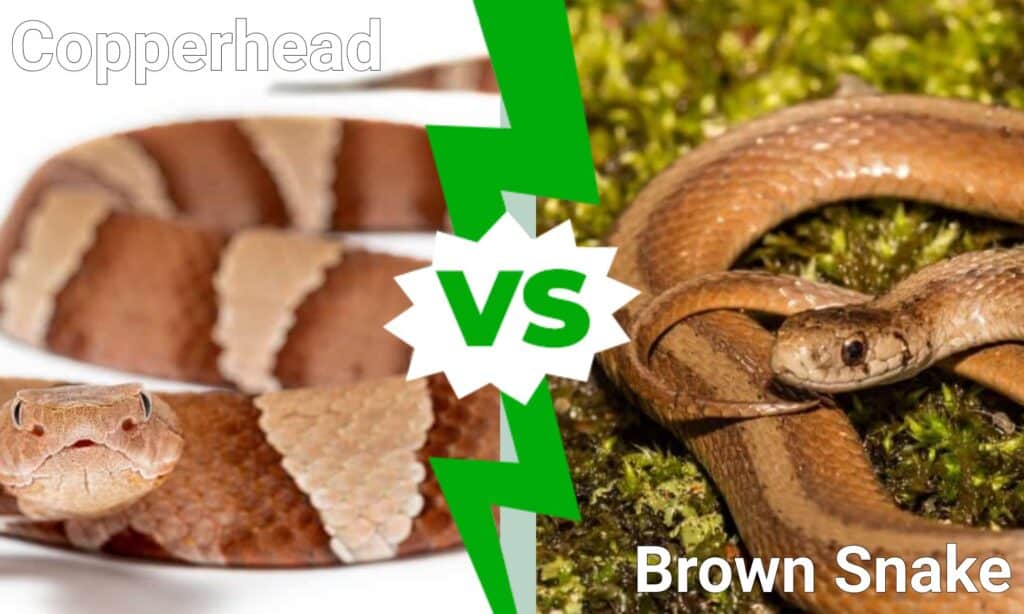
| Copperhead | Dekay’s Brown snake | |
|---|---|---|
| Color | Copper-colored base with yellow eyes and a dark brown pattern. | Light to dark brown with small black dots. |
| Size | 20-37 inches. | Usually 12 inches or less. |
| Patterns | Hourglass bands from head to tail. | Small dots along a thin dorsal stripe running from head to tail. |
| Prey | Insects, amphibians, small reptiles, other snakes, small mammals, and more. | Slugs, snails, and earthworms. |
| Venom | One of the three venomous pit vipers. | Nonvenomous. |
| Distribution | Eastern United States except for Florida. | Eastern United States and parts of Mexico. |
The 6 main differences between a Copperhead and a Brown snake
The main differences between a copperhead and a Dekay’s brown snake are that copperheads are larger, have hourglass banding patterns, and are venomous. Brown snakes are small, have small dots, and are not venomous.
Copperheads and brown snakes are easily some of the most misidentified snakes in the eastern United States. The similarities between the two mostly have to do with them both being brown, as they share little else in common. Copperheads are large, venomous snakes that belong to the pit viper family, classifying them alongside cottonmouths and rattlesnakes. Brown snakes (officially known as Dekay’s brown snake in the US) are small and nonvenomous and are extremely common. Unfortunately, both snakes are killed regularly, with the brown snake often being mistaken as a baby copperhead.
Aside from color, these snakes are quite different in almost every way. While copperheads are thick and larger, brown snakes are small and thin. Copperheads have yellow cat eyes with a slitted pupil, while brown snakes have tiny heads and little black eyes. Even the diets of the two snakes are different, with copperheads preferring larger prey like small mammals and reptiles, while brown snakes mostly eat slugs.
Let’s explore the differences between copperheads and brown snakes in a bit more detail below.
Copperhead vs Brown Snake: Color

The copperhead’s eyes have vertical pupils that make them resemble a cat’s eyes.
©Creeping Things/Shutterstock.com
The copperhead’s name gives us some clues as to its coloration. Their base layer is a flat copper color that is quite distinct from most other snakes. This copper color can vary slightly depending on the snake, with some being more reddish or pinkish while others are closer to brown. Additionally, copperheads often have yellow eyes with black-slitted pupils and a dark brown-banded pattern.
Dekay’s brown snake has a base layer of brown across its body. Different snakes can be closer to gray, but most of them are soil-colored brown that is close to tan. The patterns on a brown snake are black.
Copperhead vs Brown Snake: Size

Copperheads are much larger than brown snakes.
©Jay Ondreicka/Shutterstock.com
The copperhead isn’t large compared to other venomous snakes in the United States but is much larger than the brown snake. Copperheads generally measure 20-37 inches long. When fully grown, they can appear somewhat stocky, although not as thick as a cottonmouth.
Brown snakes are little snakes. They rarely grow past 12 inches long, with most measuring somewhere between 6-10 inches. They are slender snakes with tiny heads.
Copperhead vs Brown Snake: Patterns
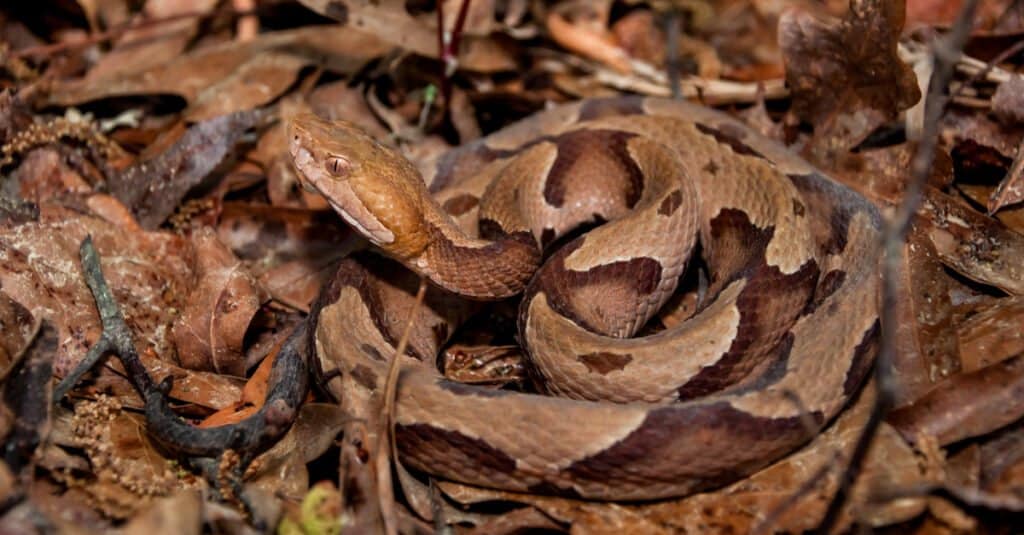
Copperheads have hourglass-shaped bands, while brown snakes have a single stripe and dots.
©Jay Ondreicka/Shutterstock.com
The bands of a copperhead are famously known to be shaped like an hourglass. Starting at the head, the hourglass pattern sits with the large segments on the sides and the thin portion across the spine. This pattern repeats down to the tail. In the broad-banded subspecies of copperhead in Texas, the pattern may just be solid bands and not hourglass-like.
Brown snakes have a distinct pattern of their own. Generally, there is a long, thin dorsal stripe that runs along their spine, although this can sometimes appear faded in some places. On either side of the dorsal spine are dots running from head to tail. Most of the time, these dots are brown, but they can occasionally appear pink.
Copperhead vs Brown Snake: Prey
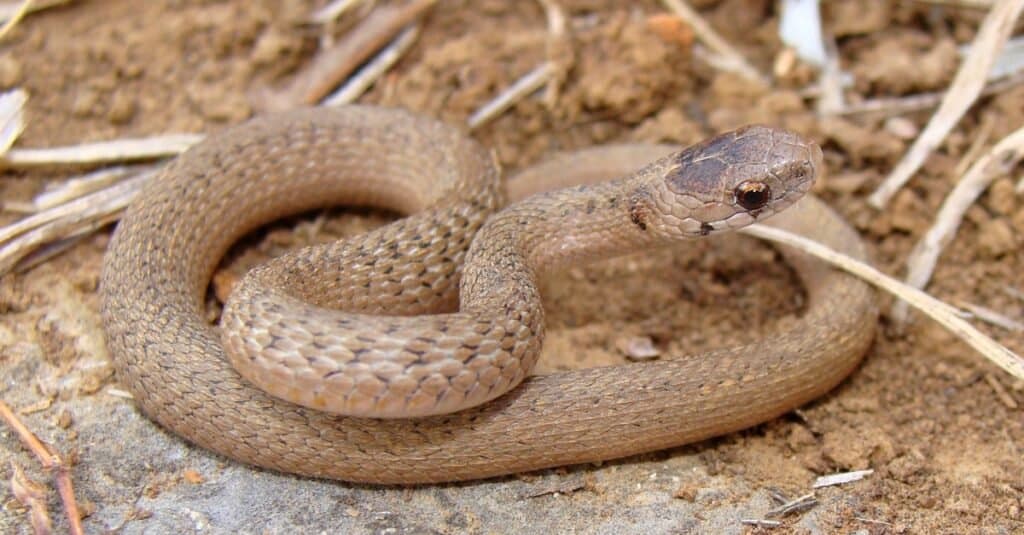
Brown snakes only eat slugs, worms, and snails.
©Matt Jeppson/Shutterstock.com
Copperheads aren’t picky when it comes to food. They are known to eat small reptiles like snakes and lizards, small mammals like mice and squirrels, insects, and more.
Brown snakes mostly eat slugs, snails, and earthworms.
Copperhead vs Brown Snake: Venom
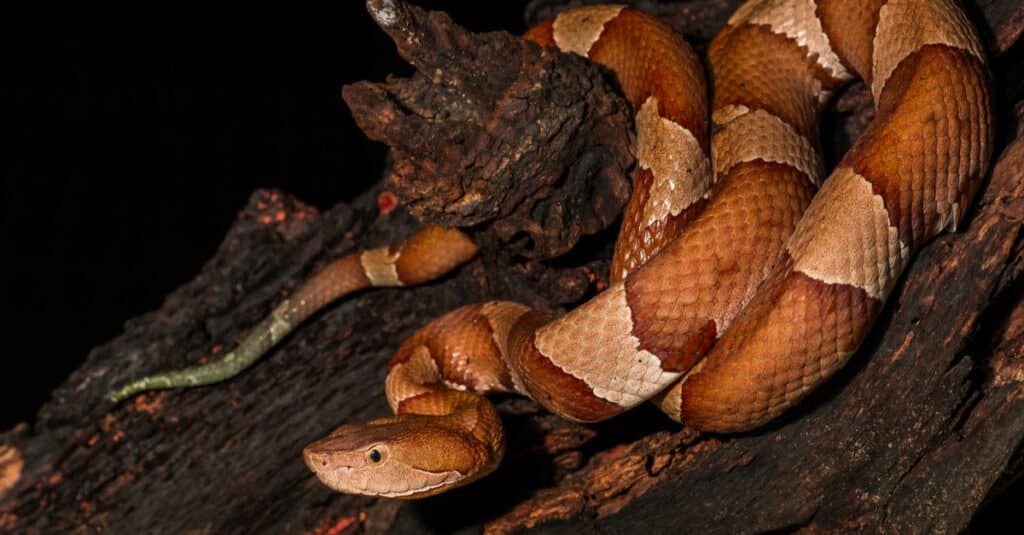
Copperheads are venomous, while brown snakes are not.
©Wildvet/Shutterstock.com
The copperhead is a pit viper, meaning it is one of the venomous species of snake that lives in the United States. Overall, the copperhead is the least venomous of the big three (copperheads, cottonmouths, and rattlesnakes). Still, medical treatment is essential to ensure no adverse reactions occur.
Brown snakes are nonvenomous.
Copperhead vs Brown Snake: Distribution
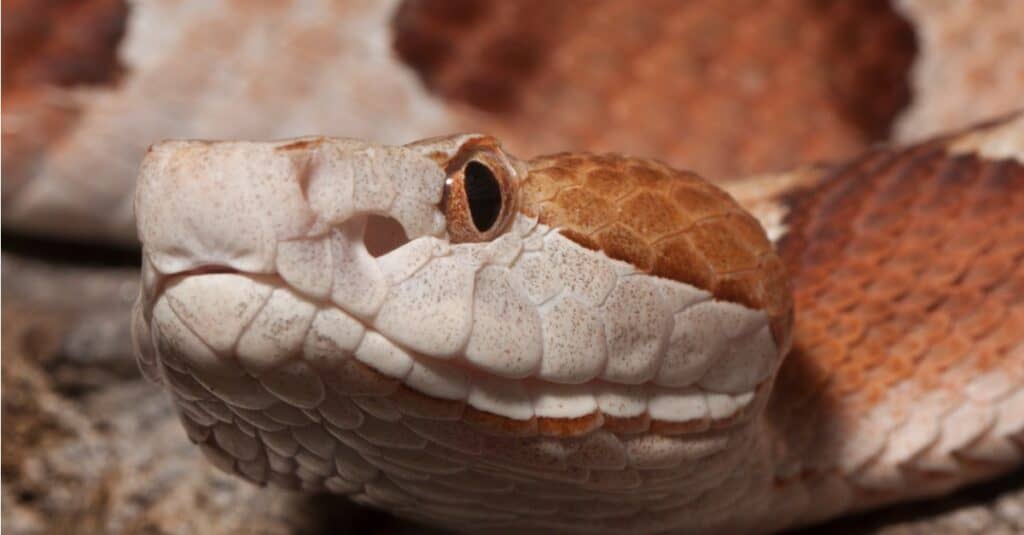
Both snakes are found across the eastern United States.
©iStock.com/Mark Kostich
The copperhead can be found across most of the eastern United States except for Florida. Their northern range extends into Massachusetts, and their western range extends into central Texas.
The brown snake has a similar distribution to the copperhead, only a bit wider. They can be found across most of the eastern United States except for Florida, as far north as Canada and the Great Lakes, and as far south as Mexico.
The photo featured at the top of this post is © iStock.com/David Kenny
Discover the "Monster" Snake 5X Bigger than an Anaconda
Every day A-Z Animals sends out some of the most incredible facts in the world from our free newsletter. Want to discover the 10 most beautiful snakes in the world, a "snake island" where you're never more than 3 feet from danger, or a "monster" snake 5X larger than an anaconda? Then sign up right now and you'll start receiving our daily newsletter absolutely free.
Thank you for reading! Have some feedback for us? Contact the AZ Animals editorial team.






